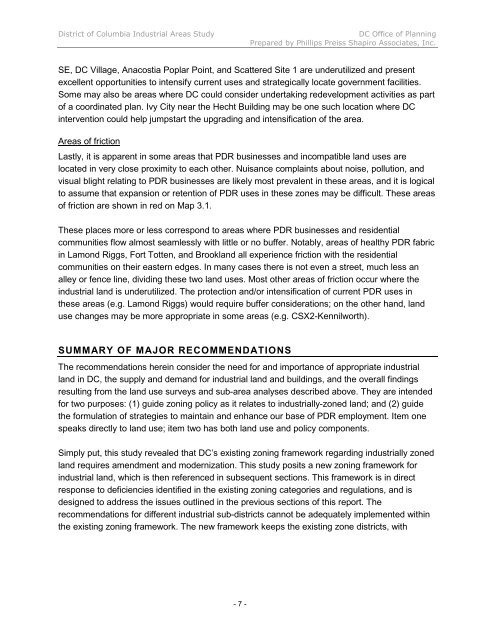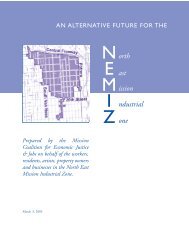INDUSTRIAL LAND IN A POST-INDUSTRIAL CITY District of ...
INDUSTRIAL LAND IN A POST-INDUSTRIAL CITY District of ...
INDUSTRIAL LAND IN A POST-INDUSTRIAL CITY District of ...
You also want an ePaper? Increase the reach of your titles
YUMPU automatically turns print PDFs into web optimized ePapers that Google loves.
<strong>District</strong> <strong>of</strong> Columbia Industrial Areas Study DC Office <strong>of</strong> Planning<br />
Prepared by Phillips Preiss Shapiro Associates, Inc.<br />
SE, DC Village, Anacostia Poplar Point, and Scattered Site 1 are underutilized and present<br />
excellent opportunities to intensify current uses and strategically locate government facilities.<br />
Some may also be areas where DC could consider undertaking redevelopment activities as part<br />
<strong>of</strong> a coordinated plan. Ivy City near the Hecht Building may be one such location where DC<br />
intervention could help jumpstart the upgrading and intensification <strong>of</strong> the area.<br />
Areas <strong>of</strong> friction<br />
Lastly, it is apparent in some areas that PDR businesses and incompatible land uses are<br />
located in very close proximity to each other. Nuisance complaints about noise, pollution, and<br />
visual blight relating to PDR businesses are likely most prevalent in these areas, and it is logical<br />
to assume that expansion or retention <strong>of</strong> PDR uses in these zones may be difficult. These areas<br />
<strong>of</strong> friction are shown in red on Map 3.1.<br />
These places more or less correspond to areas where PDR businesses and residential<br />
communities flow almost seamlessly with little or no buffer. Notably, areas <strong>of</strong> healthy PDR fabric<br />
in Lamond Riggs, Fort Totten, and Brookland all experience friction with the residential<br />
communities on their eastern edges. In many cases there is not even a street, much less an<br />
alley or fence line, dividing these two land uses. Most other areas <strong>of</strong> friction occur where the<br />
industrial land is underutilized. The protection and/or intensification <strong>of</strong> current PDR uses in<br />
these areas (e.g. Lamond Riggs) would require buffer considerations; on the other hand, land<br />
use changes may be more appropriate in some areas (e.g. CSX2-Kennilworth).<br />
SUMMARY OF MAJOR RECOMMENDATIONS<br />
The recommendations herein consider the need for and importance <strong>of</strong> appropriate industrial<br />
land in DC, the supply and demand for industrial land and buildings, and the overall findings<br />
resulting from the land use surveys and sub-area analyses described above. They are intended<br />
for two purposes: (1) guide zoning policy as it relates to industrially-zoned land; and (2) guide<br />
the formulation <strong>of</strong> strategies to maintain and enhance our base <strong>of</strong> PDR employment. Item one<br />
speaks directly to land use; item two has both land use and policy components.<br />
Simply put, this study revealed that DC’s existing zoning framework regarding industrially zoned<br />
land requires amendment and modernization. This study posits a new zoning framework for<br />
industrial land, which is then referenced in subsequent sections. This framework is in direct<br />
response to deficiencies identified in the existing zoning categories and regulations, and is<br />
designed to address the issues outlined in the previous sections <strong>of</strong> this report. The<br />
recommendations for different industrial sub-districts cannot be adequately implemented within<br />
the existing zoning framework. The new framework keeps the existing zone districts, with<br />
- 7 -












